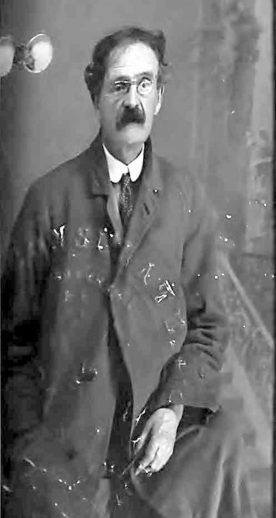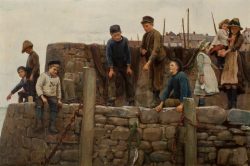Charles Boutwood in 1915, from a photograph from U.S. Consular Registration Certificates, 1907–1918 (www.ancestry.com).

Charles Edward Boutwood 1860–1937
Charles Edward Boutwood was born in Luton, in Bedfordshire, England. He studied at the Royal Academy of Arts in London and then in Paris. In the early 1880s he first visited the coastal village of Polperro, Cornwall, with painter Herbert E. Butler, and by decade’s end the two had married Polperro natives, sisters Thirza and Sophia Pond. Boutwood exhibited several paintings made in Polperro in the Royal Academy exhibition of 1885. He was on his way to Japan in 1888 when he stopped in Chicago. Staying on, he participated that year in the Art Institute’s inaugural annual exhibition for American artists and helped found the Chicago Society of Artists, of which he served as first president. Boutwood was a regular exhibitor at the Art Institute and also showed his work in other local and regional shows, including those of the Society of Western Artists and the Artists’ Guild. He won numerous prizes and served frequently as a juror. Boutwood painted landscapes in England, France, and coastal Massachusetts, figural works and genre scenes, and formal portraits, one of which was displayed at Chicago’s World’s Columbian Exposition of 1893. He worked in watercolors as well as oils, and he was also active as a book illustrator, in the mid-1890s.
Boutwood taught for some twenty-five years at the Art Institute. Between 1889 and about 1898, he and fellow faculty member John H. Vanderpoel conducted summer sketching classes in St. Joseph, Michigan; Oregon, Illinois; and Burlington and Delavan, Wisconsin, where students painted figures posed out-of-doors as well as landscapes. “As artists Mr. Boutwood and Mr. Vanderpoel are too well known to need comment,” observed a writer for the journal Brush and Pencil: “They have been closely concerned in the advancement of art interests in Chicago, and as instructors they have done long and faithful service in our Art Institute.”i Boutwood and Vanderpoel also shared a studio, between 1890 and 1893. Later, Boutwood was a tenant in the Tree Studios building on Chicago’s Near North Side.
After the turn of the century, Boutwood diversified his activities. He settled in suburban Hinsdale, Illinois, and became active in the local golfing scene. He even invented a golf ball, for which he received a patent in 1902, and he co-founded a company to manufacture sporting goods and novelties. He also taught freehand drawing at the Armour Institute of Technology, in 1911. Boutwood traveled frequently to find subjects for his paintings. Between 1913 and 1915 he lived in Trépied, on the coast of Brittany, painting impressionist peasant scenes that were well-received back in Chicago. In addition, Boutwood regularly revisited England. In 1916 he resigned from the Art Institute’s faculty to return permanently to Polperro, where he died twenty-one years later.
Wendy Greenhouse, PhD
i Louise Reidel, “Student Life at Delavan,” Brush and Pencil 2 (June 1898): 116.
